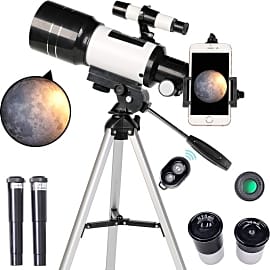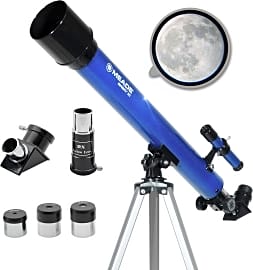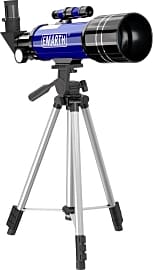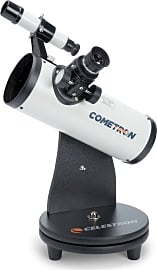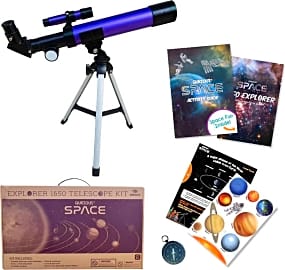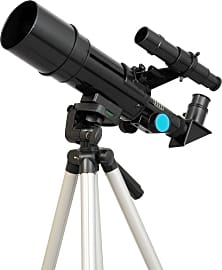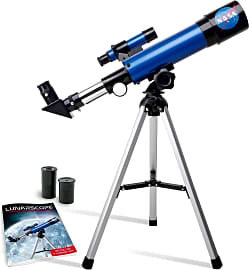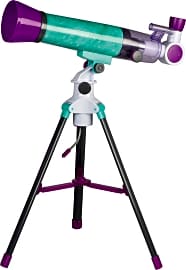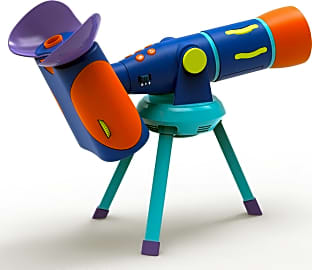The 10 Best Telescopes For Kids

This wiki has been updated 40 times since it was first published in August of 2015. Got a budding astronomer in the house? Kindle your little scientist's passions with one of these easy-to-use telescopes for kids that will have them identifying constellations and observing the craters of the moon in no time. From tabletop instruments to freestanding units on tripods, one of these is sure to please. We included models to suit a wide range of ages as well as budgets. When users buy our independently chosen editorial choices, we may earn commissions to help fund the Wiki.
Editor's Notes
October 30, 2020:
Swapped out the ToyerBee Beginner and Discover With Dr. Cool Lunar with updated models and replaced the Twin Star 76mm Cassegrain Silver with the more travel-friendly Twin Star Compact.
Although the GeoSafari Jr. Talking isn't a functioning telescope, we included it as on option for young kids who aren't ready for the real deal yet. Loaded with built-in NASA images and informative audio, it's a great toy for getting little ones as young as four years old interested in space. Nancy B's MoonScope is a brightly-colored model that's designed to appeal to girls. The included activity journal encourages STEM learning as well as creative expression, with moon-themed writing and drawing prompts. The Meade Infinity is available in a variety of apertures. If you're just starting out and want to look at relatively nearby objects like the moon, the 50mm option should be fine. If you want to upgrade, however, the 102mm allows you to see planets and focus in on details more clearly. The Orion GoScope is a great travel model for kids and adults alike. It comes with a carrying case, making it easy to take on camping trips and other vacations.
November 07, 2019:
Telescopes are an indispensable scientific tool, but they're a little bit tricky for kids to operate, and the quality ones cost a pretty penny — more, at least, than you'd be willing to dish out for a birthday gift. The items we've chosen are fully functional and can be used to observe some of the most famous celestial bodies, such as the moon and constellations. There are both tabletop and freestanding options, and many of them come with additional goodies like journals or glow-in-the-dark stickers. If your child loves astronomy, or if you're trying to spark their interest in the subject, consider picking up one of these educational toys.
The Geosafari Vega 360 and TwinStar AstroMark have been cut due to complaints concerning durability and functionality. In their place, we’ve added the ToyerBee Beginner, Qurious Explorer, and Ggienrui Educational, all of which are lightweight, easy-to-use models that have substantial viewing power.
Starry Sights
These two major categories of visible light telescopes are refractive and reflective.
Questions about the nature of the universe can have as deep an impact on children as they do on adults, possibly even more so. I once heard a philosopher posit that intelligent life exists in the universe so that the cosmos can wonder at itself, that it creates awestruck minds for the sheer joy of feeling awestruck. Human beings age and die so their energy can cycle back into the next generation, as children are more in touch with their sense of wonder than all of us jaded, world-weary adults.
If this is to be believed, then it’s your duty as a member of the universe, as a harbinger of intelligence and wonder in an otherwise empty void, to place a telescope–a veritable tool for the exacerbation of wonder–into the hands of the universe’s most ardent fanatics.
Once in their hands and aimed at some nighttime celestial body (ideally not the bodies of any neighbors), your kid’s telescope will work in one of two ways. These two major categories of visible light telescopes are refractive and reflective.
Refractive telescopes are the more common type in this category, and they work by combining a pair of convex lenses. The first of these lenses is your light-collecting element, and on either type of telescope wider tends to be better. That light enters the telescope tube and condenses toward a focal point, after which the second lens element picks it up and focuses it to your eyepiece.
Now, don’t get confused here if you see a little mirror in the eyepiece of your refracting telescope. That mirror simply reflects the light from your second lens up into an eyepiece that’s positioned for greater comfort while stargazing. It doesn’t mean your refractive telescope is also a reflector.
A reflective telescope, of which there are fewer in this category, uses a large concave mirror that collects and reflects light back up toward the central portion of the telescope. Often, manufacturers will place a much smaller mirror at this focal point to reflect the primary image up into an eyepiece.
Eyes On The Prize
You can easily tell the difference between the reflective and refractive telescopes at these price points by their body design. Even if you didn’t know that reflective telescopes often had their eyepieces toward the front end of the tube, you could tell the difference simply by identifying the refractive telescopes as longer and thinner, and the reflective telescopes as shorter and fatter.
All that said, each style has its benefit over the other even when adhering to this range of price and magnification.
That’s because the telescopes on our list all boast the same relative magnification capabilities. As refractive telescopes increase their magnification, they also increase their size, weight, and cost in direct proportion. At a certain point, it becomes unfeasible to use a giant, expensive refractor that does about the same job as a relatively smaller, lighter, less expensive reflector, especially in the somewhat weaker hands of a child.
All that said, each style has its benefit over the other even when adhering to this range of price and magnification. Because reflective telescopes have additional mirrors and optical devices in their tubes, they aren’t as good for viewing planets and the moon as refractors are. With a refractor, nothing stands between your lens elements, so bigger brighter objects will render with less diffraction.
Reflectors, on the other hand, are superior for deep-field viewing of star clusters, distant galaxies, and constellations. That’s because they have a wider light collecting area that is more sensitive to celestial objects that don’t shine as brightly as a planet or the moon would.
Knowing what kind of bodies your young one wants to explore will guide you toward one style of scope or another. After that, it’s only a matter of maximizing your magnification within your budget.
Historical Lenses
While most people think of Galileo Galilei whenever they think of the history of the telescope, his were not the first models to reveal celestial truths to the human eye.
Lens manufacture and glass grinding techniques attained a new level of refinement in the 1500s, and by 1608, a Dutchman by the name of Hans Lippershey applied for a patent on what we should consider the world’s first telescope.
The following year, Galileo got his hands on one of the Dutch models, made some refinements, and set forth to forever alter our cosmic perspective.
Due in part to the simplicity of the design (Lippershey was essentially trying to patent the idea of holding two glass lenses up at a distance from one another) and to similar patent filings cropping up from the same town over the course of a few weeks, the Dutch patent office actually denied Lippershey’s claim.
The following year, Galileo got his hands on one of the Dutch models, made some refinements, and set forth to forever alter our cosmic perspective. These were all refractive telescopes, however. In 1668, Isaac Newton built the world’s first reflective telescope, reasoning that it would be less expensive to collect more light than with the large, finely ground glass lenses of the refractors.
The styles of telescope have competed over the course of the centuries, and now laser telescopes, as well as designs built to gather data from parts of the electromagnetic spectrum beyond the light that's visible to the naked eye continue to push the field forward into the 21st century.


